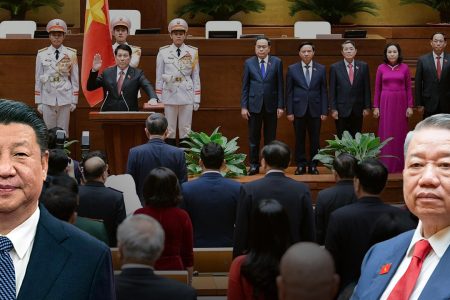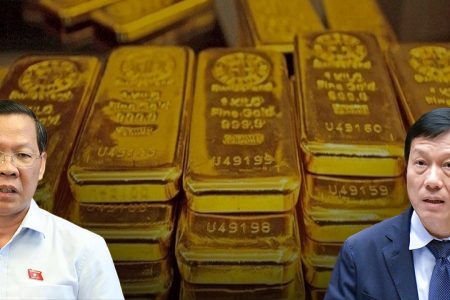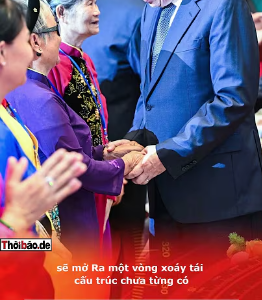
The story of more than 200 Chinese ships outlined in Whitsun Reef has been the focus of international opinion over the past week, causing tensions in the South China Sea (Vietnamese call it the East Sea), according to regional media.
Specifically, on March 7, there were about 220 “fishing boats” in the area inside Whitsun Reef.
As of March 19, the number of ships counted was still at 193.
On March 21, after detecting 220 Chinese ships here, Philippine Defense Minister Delfin Lorenzana sent a protest message to the Chinese government, asking China to withdraw the ships.
On March 27, the Philippine Defense Minister confirmed that there was currently a naval ship and a coast guard ship closely monitoring the Chinese group.
„We maintain our stance and urge Beijing to withdraw the ship immediately,“ Mr. Lorenzana stressed.
Australia, the US, and Japan have spoken out against the infringement of the Philippines‘ EEZ.
US Secretary of State Antony Blinken announced on Twitter on the morning of March 29: „We will always stand side by side with our allies and stand up to defend the rules-based international order.“
What is Whitsun Reef?
The Whitsun Reef, (also known in China as Nguu A Tieu and Ba Dau in Vietnamese) is a V-shaped reef with a total area of about 10 square kilometers, which only rises out of the water during low tide.
On his personal page, South China Sea expert Song Phan analyzed, this is an underground beach, with no place above the water. Therefore, this LTE (low tide) is only a part of the seabed, no one can claim sovereignty.
However, according to him, Whitsun Reef is located within 12 nautical miles of Sinh Ton Dong (Grierson Reef), so according to UNCLOS, it is part of the territorial sea of Grierson Reef, under the sovereignty of Vietnam.
He wrote on Facebook: „Vietnam claims the sovereignty of Sinh Ton Dong and has been stationed here continuously since at least March 15, 1978, up to now. According to that situation, Whitsun Reef belongs to the sovereignty of Vietnam as is the internal waters / territorial sea of Sinh Ton Dong despite its geographical position within the EEZ (exclusive economic zone) of the Philippines.“
Many people questioned, as soon as the Chinese fishing vessel was discovered staging in Whitsun Reef and even though it was only in the EEZ of the Philippines, not under the sovereignty like Vietnam, the Philippines spoke earlier than Vietnam.
On March 25, Vietnamese Ministry of Foreign Affairs spokeswoman Le Thi Thu Hang affirmed that Chinese fishing vessels in Whitsun Reef had violated Vietnam’s sovereignty, violating the Convention’s provisions on the operation of water vessels in the coastal national territorial waters and contrary to the Declaration on the Conduct of Parties in the East Sea (DOC).
On March 28, Philippine Defense Minister Delfin Lorenzana confirmed that the country’s warplanes and military aircraft will monitor the Chinese group of ships in the Whitsun Reef „every day“ and repeat the previous request to ask Beijing to withdraw the vessels.
What does China plan to do at Whitsun Reef?
In the face of international reactions, China has confirmed that these are the refugees, while the Philippines describes them as China’s marine militia force (PAFMM).
Former Judge Antonio Carpio on March 24 said on Twitter that the presence of Chinese ships is a „prelude“ to the occupation of the reef.
He noted the move recalled what happened to Vanh Khan (Mischief Reef), where China said it was only to build a shelter for fishermen but now to become a military base.
Assoc. Prof. Ph.D. Vu Thanh Ca analyzed Tuoi Tre newspaper that this is China’s “gray-zone” tactic.
In this tactic, China attaches great importance to the use of marine militias.
These vessels are also equipped with a number of fishing means, but their primary task is not to fish but to organize coercive activities, bullying fishing vessels and vessels to enforce the law of the countries surrounding the South China Sea.
Activities of these fishing vessels and law enforcement vessels are carried out by countries in their own waters, but in the eyes of China, it is „overlapping“ with the illegal „jurisdiction“ waters within range of „U-shaped line“ or „related waters“ of China.
Vietnamese research documents confirm the sovereignty overriding phenomenon macro in the South China Sea:
„… The coastal states are located opposite or adjacent to each other when determining the extent of the seas and continental shelf in accordance with the provisions of UNCLOS 1982 and depending on the coastal distance of the opposite or adjacent countries. Neighboring countries have created overlapping inland waters, overlapping territorial waters, overlapping exclusive economic zones, and overlapping continental shelves …, „a page of the National Assembly of Vietnam published in January 2020.
Dr. Vu Thanh Ca said on the Tuoi Tre page:
„The fact that more than 220 Chinese ships are anchored in the Whitsun Reef area of the Truong Sa (Spratlys) is a very questionable activity. Countries surrounding the South China Sea need to be wary of the fact that Chinese ships are anchored in the area because China is most likely making a plot to change the status quo of the area, even occupy this rock.“
Thoibao.de (Translated)




























